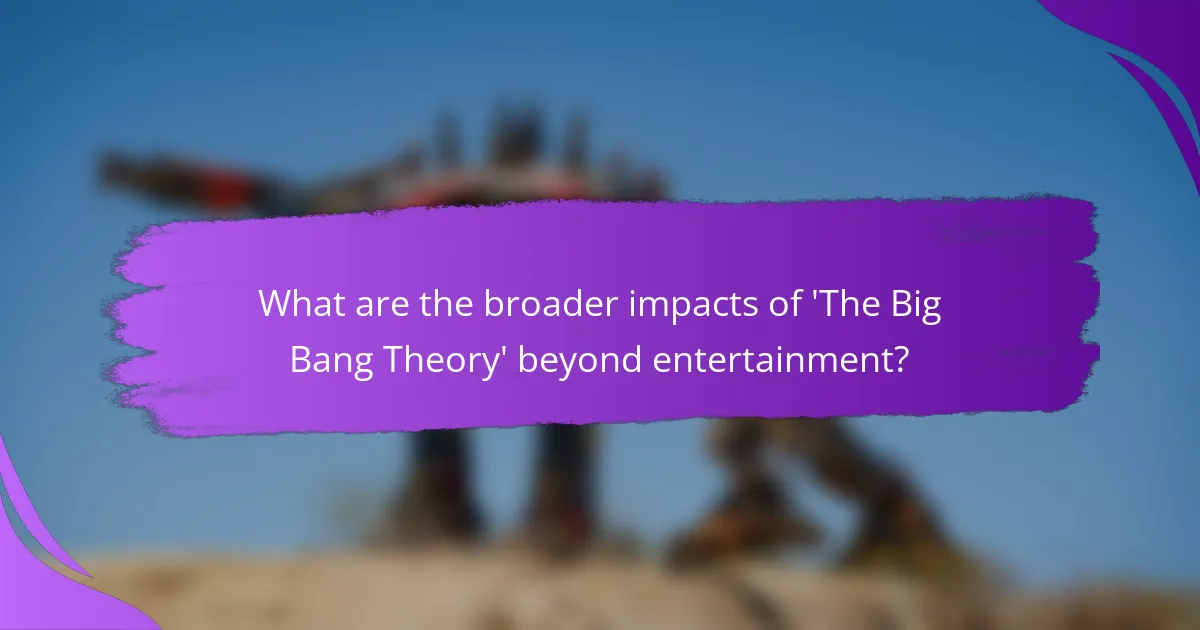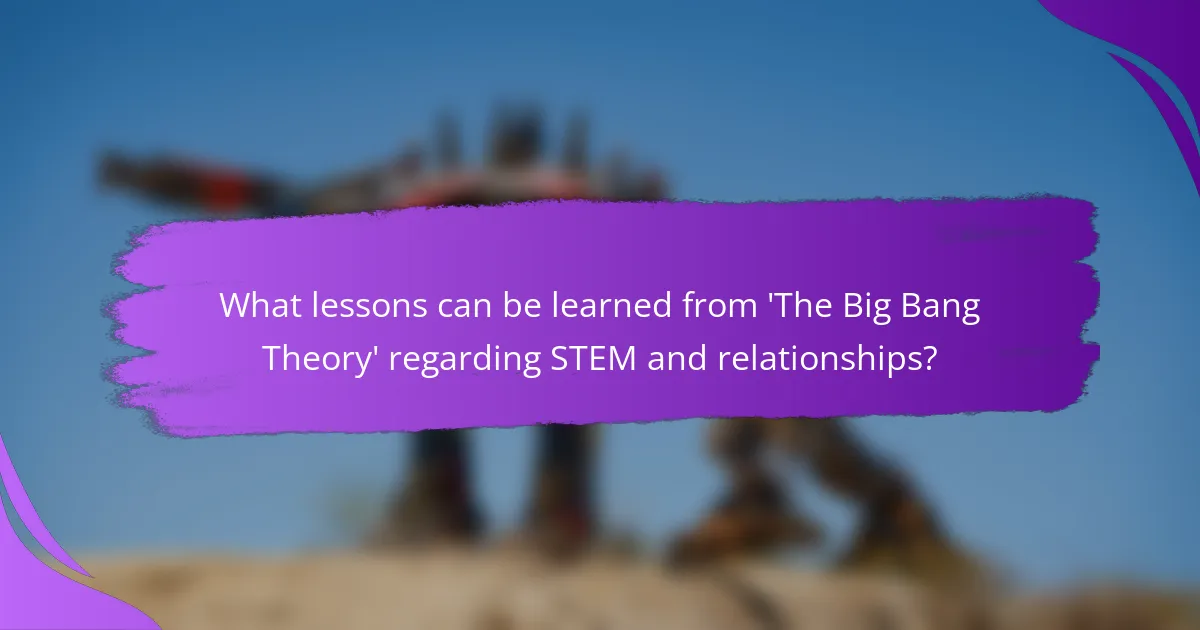‘The Big Bang Theory’ is a television sitcom that aired from 2007 to 2019, focusing on a group of socially awkward scientists and their interactions. The show played a pivotal role in popularizing STEM (Science, Technology, Engineering, and Mathematics) fields, contributing to the mainstream acceptance of geek culture. It sparked curiosity about scientific concepts among viewers while portraying relationships and friendships in a relatable manner. Additionally, the series has influenced social dynamics and discussions around emotional intelligence, highlighting how shared interests in science can foster connections. Overall, ‘The Big Bang Theory’ has left a lasting impact on society by enhancing public understanding of STEM and promoting inclusivity in geek culture.

What is ‘The Big Bang Theory’ and its significance in popular culture?
‘The Big Bang Theory’ is a television sitcom that aired from 2007 to 2019. It centers on a group of socially awkward scientists and their interactions with each other and the outside world. The show gained immense popularity, attracting millions of viewers worldwide. It contributed to the mainstream acceptance of geek culture and interest in STEM (Science, Technology, Engineering, and Mathematics) fields. The characters often discussed scientific concepts, which sparked curiosity among viewers. The show’s humor made complex topics more accessible. Additionally, it portrayed relationships and friendships in a unique way, resonating with audiences. ‘The Big Bang Theory’ has influenced merchandise, conventions, and even academic discussions on science communication.
How did ‘The Big Bang Theory’ influence perceptions of STEM fields?
‘The Big Bang Theory’ positively influenced perceptions of STEM fields by making science and technology relatable and entertaining. The show featured characters who were scientists and engineers, showcasing their intelligence and expertise. This representation helped demystify STEM careers for the audience. Viewers began to see these fields as accessible and desirable. The series highlighted the social lives of characters in STEM, breaking stereotypes of the “lonely genius.” Additionally, it sparked interest in science topics through humor and storytelling. Research indicates that exposure to such media can increase interest in STEM education among young viewers. The show’s popularity contributed to a broader cultural acceptance of geek culture and intellectual pursuits.
What specific STEM concepts were introduced in ‘The Big Bang Theory’?
‘The Big Bang Theory’ introduced various specific STEM concepts, including quantum mechanics, string theory, and the theory of relativity. Quantum mechanics was illustrated through discussions about Schrödinger’s cat and particle entanglement. String theory was referenced in relation to multiple dimensions and the fundamental nature of particles. The theory of relativity was highlighted in episodes discussing time dilation and the implications of traveling at light speed. Additionally, concepts from astrophysics, such as black holes and the Big Bang, were frequently explored. The show effectively used humor to make these complex ideas accessible to a general audience.
How did the show portray scientists and their work?
The show portrayed scientists as socially awkward yet brilliant individuals. Characters like Sheldon Cooper and Leonard Hofstadter exemplified this stereotype. Their work in physics and engineering was often depicted with humor and complexity. The show highlighted their passion for science through various experiments and discussions. It also showcased their collaborations, emphasizing teamwork in scientific endeavors. Relationships among the scientists added a personal dimension to their professional lives. Episodes often included references to real scientific theories and principles. This blend of humor and accuracy contributed to popularizing STEM fields. Overall, the portrayal was a mix of comedic elements and genuine appreciation for scientific work.
In what ways did ‘The Big Bang Theory’ shape relationships among characters?
‘The Big Bang Theory’ significantly shaped relationships among characters through humor, shared interests, and personal growth. The series often showcased how characters bonded over their love for science and geek culture. This common ground created strong friendships, particularly among Sheldon, Leonard, Howard, and Raj. Romantic relationships also evolved, notably between Leonard and Penny, which highlighted the challenges of differing backgrounds. The show depicted how characters supported each other during personal struggles, fostering deeper connections. Additionally, character development over the seasons illustrated growth in relationships, such as Sheldon’s increasing emotional intelligence. Overall, the interactions emphasized the importance of acceptance and understanding in friendships and romantic partnerships.
How did romantic relationships develop throughout the series?
Romantic relationships in “The Big Bang Theory” evolved significantly over the series. Initially, relationships were primarily comedic and awkward. Leonard’s infatuation with Penny set the stage for romantic dynamics. As the series progressed, Leonard and Penny’s relationship deepened, leading to their eventual marriage. Sheldon and Amy’s relationship showcased a unique take on romance, emphasizing intellectual compatibility. Howard and Bernadette’s relationship highlighted growth and maturity as they navigated marriage and parenthood. Each couple’s journey reflected broader themes of love, acceptance, and personal development. The series effectively blended humor with relatable relationship challenges, enhancing its appeal.
What role did friendship play in the dynamics of the characters?
Friendship played a crucial role in the dynamics of the characters in “The Big Bang Theory.” It fostered emotional support among the main characters. Their friendships helped navigate personal challenges and social awkwardness. For instance, Sheldon relied on Leonard for companionship and guidance. Howard and Raj’s friendship provided a comedic relief and showcased loyalty. The group’s interactions often emphasized collaboration and teamwork in both personal and professional settings. These friendships also highlighted the importance of acceptance in a geek culture context. Overall, friendship was a foundational element that shaped character development and plot progression.
How did ‘The Big Bang Theory’ contribute to the acceptance of geek culture?
‘The Big Bang Theory’ significantly contributed to the acceptance of geek culture by portraying nerdy characters in a positive light. The show featured intelligent and socially awkward individuals who embraced their interests in science, technology, and comic books. This representation helped normalize geek culture in mainstream media.
The show’s popularity led to increased visibility for conventions, gaming, and comic books. Merchandise related to the show, such as T-shirts and collectibles, became widely accepted. Characters like Sheldon Cooper became cultural icons, further bridging the gap between mainstream and geek culture.
The series also included references to popular geek domains, such as video games and comic book franchises. This integration encouraged viewers to engage with these interests, fostering a sense of community among fans. Overall, ‘The Big Bang Theory’ played a crucial role in reshaping perceptions of geek culture, making it more relatable and socially acceptable.
What elements of geek culture were highlighted in the show?
The show highlighted various elements of geek culture, including comic books, video games, and science fiction. Characters often referenced popular franchises like Star Wars and Star Trek. They engaged in tabletop gaming, showcasing Dungeons & Dragons sessions. The series portrayed conventions, emphasizing events like Comic-Con. It also featured discussions on scientific theories and nerdy trivia. Additionally, the characters exhibited traits such as social awkwardness and intellectualism, common in geek culture. Overall, the show celebrated and normalized these aspects, making them accessible to a broader audience.
How did the show impact the visibility of nerdy hobbies and interests?
The show significantly increased the visibility of nerdy hobbies and interests. It portrayed characters who engaged in activities like comic book reading, video gaming, and science fiction fandom. This representation made such interests more socially acceptable. The show attracted a diverse audience, including those who previously felt marginalized. It sparked conversations about geek culture in mainstream media. Merchandise related to the show, such as action figures and apparel, became widely popular. Academic discussions often reference the show as a catalyst for the nerd culture renaissance. Its success demonstrated that nerdy pursuits could be both entertaining and relatable.

What are the broader impacts of ‘The Big Bang Theory’ beyond entertainment?
‘The Big Bang Theory’ has significantly impacted society beyond entertainment by popularizing STEM fields. The show has inspired interest in science, technology, engineering, and mathematics among viewers. Research indicates that exposure to scientific concepts through media can enhance public understanding of these fields. For instance, a study published in the journal “Science Communication” found that science-themed television shows increase viewers’ science literacy.
Additionally, the series has contributed to the normalization of geek culture. It portrays characters who embrace their intellectual interests, which has led to greater acceptance of nerdy hobbies. This shift has encouraged individuals to pursue careers in STEM, with a notable increase in enrollment in related academic programs post-show.
Furthermore, ‘The Big Bang Theory’ has influenced social dynamics by showcasing diverse relationships. The characters navigate friendships and romantic connections, promoting discussions around social interactions and emotional intelligence. This portrayal has resonated with audiences, leading to a broader understanding of interpersonal relationships in contemporary society.
How did the show encourage interest in STEM education?
The show “The Big Bang Theory” encouraged interest in STEM education by featuring relatable characters who are scientists. It presented complex scientific concepts in an accessible and humorous manner. The show’s plotlines often revolved around scientific discoveries and experiments. This portrayal sparked curiosity among viewers about various STEM fields. Additionally, the characters’ passion for science inspired audiences to explore these subjects further. The show’s popularity led to increased enrollment in STEM-related courses and programs. Research indicates that media representations can positively influence educational pursuits in these areas.
What initiatives or programs were inspired by ‘The Big Bang Theory’?
The Big Bang Theory inspired several initiatives and programs aimed at promoting STEM education and geek culture. One notable initiative is the “Big Bang Theory Science Scholarship,” which supports students pursuing degrees in science and technology. Another program is “The Big Bang Theory’s STEM Outreach,” which collaborates with educational institutions to create engaging science curricula. Additionally, the show’s popularity led to events like “Science and Comic Con,” where fans can explore scientific topics through interactive sessions. These initiatives reflect the show’s impact on encouraging interest in science among younger audiences.
How did the show affect enrollment in STEM-related fields?
The show “The Big Bang Theory” positively affected enrollment in STEM-related fields. Studies indicate that viewership of the show correlated with increased interest in science and engineering degrees. For instance, a report by the National Science Foundation noted a rise in applications to STEM programs following the show’s popularity. Additionally, a survey conducted by the American Chemical Society found that 40% of respondents stated the show inspired them to pursue a STEM career. The show’s portrayal of scientists as relatable and engaging figures contributed to this trend. Overall, “The Big Bang Theory” played a significant role in making STEM fields more appealing to a broader audience.
In what ways did ‘The Big Bang Theory’ change social perceptions of geeks?
‘The Big Bang Theory’ significantly changed social perceptions of geeks by portraying them as relatable and multidimensional characters. The show featured protagonists who excelled in science and technology while also navigating personal relationships. This representation helped to humanize geeks, showcasing their struggles and triumphs in everyday life.
Before the show, geeks were often stereotyped as socially awkward and isolated. ‘The Big Bang Theory’ challenged this stereotype by depicting friendships, romantic relationships, and social interactions among geek characters. The humor and relatability of these characters resonated with a broader audience.
As a result, the show contributed to a shift in societal views, making geek culture more accepted and celebrated. The popularity of the series led to increased interest in STEM fields among viewers. In 2014, a survey indicated that 92% of fans felt more positively about science and technology due to the show.
Overall, ‘The Big Bang Theory’ played a crucial role in normalizing geek identity and fostering a more inclusive understanding of geek culture.
What stereotypes were challenged by the characters in the show?
The characters in “The Big Bang Theory” challenged stereotypes about nerds and scientists. They portrayed intelligent individuals as socially awkward yet capable of forming meaningful relationships. The show depicted female characters in STEM roles, countering the stereotype that science is a male-dominated field. Additionally, it showcased the complexity of nerd culture, moving beyond simplistic portrayals of geeks. Characters like Amy and Bernadette exemplified successful women in science, breaking traditional gender roles. The humor in the show also highlighted that intelligence does not preclude social skills. Overall, the series reshaped perceptions of nerds, making them relatable and multifaceted.
How did the show promote inclusivity within geek culture?
The show promoted inclusivity within geek culture by featuring diverse characters and storylines. It included women in STEM roles, showcasing their expertise and contributions. Characters like Amy Farrah Fowler and Bernadette Rostenkowski challenged stereotypes about women in science. The show also highlighted friendships across different backgrounds and interests. This representation encouraged viewers to embrace diversity in geek culture. It provided relatable experiences for underrepresented groups. The positive portrayal of these characters fostered a more inclusive community. This approach resonated with audiences and sparked discussions about representation in media.

What lessons can be learned from ‘The Big Bang Theory’ regarding STEM and relationships?
‘The Big Bang Theory’ teaches that STEM expertise can enhance personal relationships. Characters like Sheldon and Amy show how intellectual compatibility fosters connection. The series highlights the importance of communication in relationships, particularly in STEM contexts. Misunderstandings often arise from technical jargon. The show illustrates how shared interests in science can bridge gaps between different personalities. It also portrays the acceptance of nerd culture, promoting inclusivity. Overall, the series emphasizes that passion for STEM can positively influence interpersonal dynamics.
What practical tips can viewers take away from the show?
Viewers can take away practical tips on embracing curiosity and learning. The show emphasizes the importance of asking questions and seeking knowledge. Characters often explore scientific concepts, showcasing how curiosity leads to understanding. Additionally, the show highlights the value of friendship and communication in relationships. Viewers can learn to express their feelings and support their friends. Engaging in geek culture is also encouraged, promoting the idea that interests in science fiction and technology are valid and enjoyable. Overall, the show inspires viewers to pursue their passions and foster connections with others.
How can the portrayal of relationships inform real-life interactions?
The portrayal of relationships in media, such as “The Big Bang Theory,” can significantly inform real-life interactions. Characters demonstrate various relationship dynamics that viewers can observe and learn from. The show highlights communication styles, conflict resolution, and emotional support among friends and partners. These portrayals can influence how individuals approach their own relationships. Research indicates that media representations shape societal norms and expectations regarding relationships. For example, viewers may adopt positive behaviors seen on screen, such as open communication, which can enhance their personal interactions. Studies show that relatable characters can lead to increased empathy and understanding in real-life scenarios.
What strategies can be adopted to foster interest in STEM fields?
Engaging students in STEM fields can be achieved through various strategies. First, incorporating hands-on learning experiences makes STEM subjects more relatable. Research shows that students retain information better when they actively participate. Second, promoting STEM role models can inspire students. For instance, showcasing diverse scientists and engineers helps students see themselves in those careers. Third, integrating technology into the curriculum captures students’ interest. A study by the National Science Foundation indicates that technology use in classrooms enhances student engagement. Fourth, creating collaborative projects encourages teamwork and problem-solving skills. Group work has been shown to improve student motivation and performance. Lastly, organizing STEM-related extracurricular activities, such as clubs or competitions, fosters a sense of community and excitement around STEM. These strategies collectively build a strong foundation for interest in STEM fields.
‘The Big Bang Theory’ is a television sitcom that aired from 2007 to 2019, focusing on socially awkward scientists and their interactions. The show significantly contributed to the popularization of STEM fields by making complex scientific concepts relatable and entertaining, while also reshaping perceptions of geek culture and relationships. Key themes include the portrayal of scientists, the evolution of friendships and romantic relationships, and the impact on societal acceptance of nerdy hobbies. The series has inspired initiatives promoting STEM education and increased enrollment in related fields, highlighting its broader cultural significance.